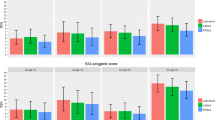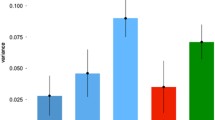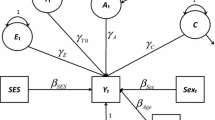Abstract
The genetic influence on the association between contemporaneously measured intelligence and academic achievement in childhood was examined in nationally representative cohorts from England and The Netherlands using a whole population indirect twin design, including singleton data. We identified 1,056 same-sex (SS) and 495 opposite-sex (OS) twin pairs among 174,098 British 11 year-olds with test scores from 2004, and, 785 SS and 327 OS twin pairs among 120,995 Dutch schoolchildren, aged 8, 10 or 12 years, with assessments from 1994 to 2002. The estimate of intelligence heritability was large in both cohorts, consistent with previous studies (h 2 = 0.70 ± 0.14, England; h 2 = 0.43 ± 0.28–0.67 ± 0.31, The Netherlands), as was the heritability of academic achievement variables (h 2 = 0.51 ± 0.16–0.81 ± 0.16, England; h 2 = 0.36 ± 0.27–0.74 ± 0.27, The Netherlands). Additive genetic covariance explained the large majority of the phenotypic correlations between intelligence and academic achievement scores in England, when standardised to a bivariate heritability (Biv h 2 = 0.76 ± 0.15–0.88 ± 0.16), and less consistent but often large proportions of the phenotypic correlations in The Netherlands (Biv h 2 = 0.33 ± 0.52–1.00 ± 0.43). In the British cohort both nonverbal and verbal reasoning showed very high additive genetic covariance with achievement scores (Biv h 2 = 0.94–0.98; Biv h 2 = 0.77–1.00 respectively). In The Netherlands, covariance estimates were consistent across age groups. The heritability of intelligence–academic achievement associations in two population cohorts of elementary schoolchildren, using a twin pair extraction method, is at the high end of estimates reported by studies of largely preselected twin samples.


Similar content being viewed by others
References
Baker LS, Treloar SA, Reynolds CA, Heath AC, Martin NG (1996) Genetics of educational attainment in Australian twins: sex differences and secular changes. Behav Genet 26:89–102
Bartels M, Rietveld MJH, Van Baal CGM, Boosma DI (2002) Heritability of educational achievement in 12-year-olds and the overlap with cognitive ability. Twin Res 5:544–553
Benyamin B, Wilson V, Whalley LJ, Visscher PM, Deary IJ (2005) Large, consistent estimates of the heritability of cognitive ability in two entire populations of 11-year-old twins from Scottish Mental Surveys of 1932 and 1947. Behav Genet 35:525–534
Calvin C, Fernandes C, Smith P, Visscher PM, Deary IJ (2009) Is there still a cognitive cost of being a twin in the UK? Intelligence 37:243–248
Calvin CM, Deary IJ, Fenton C, Roberts BA, Der G, Leckenby N, Batty GD (2011) Intelligence in youth and all-cause-mortality: systematic review with meta-analysis. Int J Epidemiol 40:626–644
Davies G, Tenesa A, Payton A, Yang J, Harris SE, Liewald D et al (2011) Genome-wide association studies establish that human intelligence is highly heritable and polygenic. Mol Psychiatry 16:996–1005
Deary IJ, Johnson W (2010) Intelligence and education: causal perceptions drive analytic processes and therefore conclusions. Int J Epidemiol 39:1362–1369
Deary IJ, Spinath FM, Bate TC (2006) Genetics of intelligence. Eur J Hum Genet 14:690–700
Deary IJ, Strand S, Smith P, Fernandes C (2007) Intelligence and educational achievement. Intelligence 35:13–21
Deary IJ, Johnson W, Houlihan LM (2009) Genetic foundations of human intelligence. Hum Genet 126:215–232
Devlin B, Daniels M, Roeder K (1997) The heritability of IQ. Nature 388:468–471
Directgov (2011) National Curriculum teacher assessments and key stage tests. http://www.direct.gov.uk/en/Parents/Schoolslearninganddevelopment/ExamsTestsAndTheCurriculum/DG_10013041. Retrieved 7 July 2011
Driessen G, Van Langen A, Oudenhoven X (1994) De toetsen voor de cohort Primair onderwijs, verantwoording. Nijmegen ITS
Driessen G, Van Langen A, Vierke H (2004) Basisrapportage PRIMA-cohortonderzoek, Vijfde meting 2002–2003. Report on PRIMA-longitudinal research project, Survey 2002–2003, Nijmegen
Dunn A, Macfarlane A (1996) Recent trends in the incidence of multiple births and associated mortality in England and Wales. Arch Dis Child Fetal Neonatal Ed 75:F10–F19
Fisch GS (2009) Models of human behaviour: talking to the animals. In: Kim Y-K (ed) Handbook of behavior genetics. Springer, New York
Gilmour AR, Gogel BJ, Cullis BR, Thompson R (2009) ASReml User Guide Release 3.0. VSN International Ltd, Hemel Hempstead. www.vsni.co.uk
Hart SA, Petrill SA, Thompson LA, Plomin R (2009) The ABCs of math: a genetic analysis of mathematics and its links with reading ability and general cognitive ability. J Educ Psychol 101:388–402
Haworth CMA, Wright MJ, Luciano M, Martin NG, de Geus EJC, van Beijsterveldt CEM et al (2010) The heritability of general cognitive ability increases linearly from childhood to young adulthood. Mol Psychiatry 15:1112–1120
Hoekstra RA, Bartels M, Boomsma DI (2007) Longitudinal genetic study of verbal and nonverbal IQ from early childhood to young adulthood. Learn Individ Differ 17:97–114
Imaizumi Y (2003) A comparative study of zygotic twinning and triplet rates in eight countries, 1972–1999. J Biosoc Sci 35:287–302
Johnson W, McGue M, Iacono WG (2006) Genetic and environmental influences on academic achievement trajectories during adolescence. Dev Psychol 42:514–532
Kaprio J (2011) Specific advantages of twin registries and biobanks. In: Walker JM (ed) Methods in molecular biology. Springer, New York
Kovas Y, Haworth CMA, Dale PS, Plomin R (2007) The genetic and environmental origins of learning abilities and disabilities in the early school years. Monogr Soc Res Child Dev 72(3):1–144
Lindahl E, Lindahl M, Oosterbeek H, Webbink D (2007) The effect of extra funding for disadvantaged pupils on achievement. Rev Econ Stat 89:721–736
Lleras-Muney A (2005) The relationship between education and adult mortality in the United States. Rev Econ Stud 72:189–221
Luciano M, Smith GA, Geffen GM, Geffen LB, Martin NG (2001) Genetic covariance among measures of information processing speed, working memory, and IQ. Behav Genet 31:581–592
Luciano M, Wright MJ, Duffy DL, Wainwright MA, Zhu G, Evans DM et al (2006) Genome-wide scan of IQ finds significant linkage to a quantitative trait locus on 2q. Behav Genet 36:45–55
Luo D, Thompson LA, Detterman DK (2003) Phenotypic and behavioural genetic covariation between elemental cognitive components and scholastic measures. Behav Genet 33:221–246
Lykken DT, McGue M, Tellegen A (1987) Recruitment bias in twin research: the rule of two-thirds reconsidered. Behav Genet 17:343–362
Martin NG (1975) The inheritance of scholastic abilities in a sample of twins. Ann Hum Genet 39:219–229
Neale MC (2009) Biometrical models in behavioural genetics. In: Kim Y-K (ed) Handbook of behavior genetics. Springer, London
Neale MC, Cardon LR (1992) Methodology for genetic studies of twins and families. Kluwer, Dordrecht
Petrill SA, Wilkerson B (2000) Intelligence and achievement: a behavioural genetic perspective. Educ Psychol Rev 12:185–197
Plomin R, DeFries JC, McClearn GE, McGuffin P (2009) Behavioral genetics, 5th edn. Worth Publishers, New York
Posthuma D, Luciano M, de Geus EJC, Wright MJ, Slagboom PE, Montgomery GW, Boomsma DI, Martin NG (2005) A genomewide scan for intelligence identifies quantitative trait loci on 2q and 6p. Am J Hum Genet 77:318–326
Richards M, Sacker A (2011) Is education causal? Yes. Int J Epidemiol 40:516–518
Rietveld MJH, van Baal GCM, Dolan CV, Boosma DI (2000) Genetic factor analyses of specific cognitive abilities in 5-year-old Dutch children. Behav Genet 30:29–40
Scarr-Salapatek S (1971) Race, social class, and IQ. Science 174:1285–1295
Smith P, Fernandes C, Strand S (2001) Cognitive Abilities Test Third Edition: technical manual. GL Assessment, London
Strenze T (2007) Intelligence and socioeconomic success: a meta-analytic review of longitudinal research. Intelligence 35:401–426
Thompson LA, Detterman DK, Plomin R (1991) Associations between cognitive abilities and scholastic achievement: genetic overlap but environmental influences. Psychol Sci 2:158–165
Turkheimer E, Haley A, Waldron M, D’Onofrio B, Gottesman II (2003) Socioeconomic status modifies heritability of IQ in young children. Psychol Sci 14:623–628
Visscher PM, Benyamin B, White I (2004) The use of linear mixed models to estimate variance components from data on twin pairs by maximum likelihood. Twin Res 7:670–674
Wadsworth SJ, DeFries JC, Fulker DW, Plomin R (1995) Cognitive ability and academic achievement in the Colorado Adoption Project: a multivariate genetic analysis of parent–offspring and sibling data. Behav Genet 25:1–15
Wainwright MA, Wright MJ, Geffen GM, Luciano M, Martin NG (2005) The genetic basis of academic achievement on the Queensland Core Skills test and its shared genetic variance with IQ. Behav Genet 35:133–145
Wainwright MA, Luciano M, Montgomery GW, Geffen GM, Martin NG (2006) A linkage study of academic skills defined by the Queensland Core Skills Test. Behav Genet 36:56–64
Webbink D, Roeleveld J, Visscher PM (2006) Identification of twin pairs from large population-based samples. Twin Res Hum Genet 9:496–500
Webbink D, Posthuma D, Boomsma DI, de Geus EJC, Visscher PM (2008) Do twins have lower cognitive ability than singletons? Intelligence 36:539–547
Weinberg W (1901) Beitrage zur physiologie und pahtologie der mehrlingsbeburten beim menschen. Arch Ges Physiol 88:346–430
Acknowledgments
The authors thank the UK Government’s Department for Education for granting permission to use the Key Stage 2 educational data and GL Assessment for providing both data for the British cohort. The Dutch data are already available to the public. The work was undertaken by The University of Edinburgh Centre for Cognitive Ageing and Cognitive Epidemiology, part of the cross council Lifelong Health and Wellbeing Initiative (G0700704/84698). Funding from the Biotechnology and Biological Sciences Research Council (BBSRC); Engineering and Physical Sciences Research Council (EPSRC); Economic and Social Research Council (ESRC); and Medical Research Council (MRC) is gratefully acknowledged.
Conflict of interest
None.
Author information
Authors and Affiliations
Corresponding author
Additional information
Edited by Deborah Finkel
Appendix 1: Univariate and multivariate parameter estimate formulae
Appendix 1: Univariate and multivariate parameter estimate formulae
(i) The proportions of variance attributed to additive genetic (\( \hat{h}^{2} \)), shared environment (\( \hat{c}^{2} \)) and unique environment (\( \hat{e}^{2} \)) effects in univariate models were estimated for intelligence and academic achievement scores, as:
where \( \hat{p} \) is the estimated proportion of MZ twins among same sex pairs (Benyamin et al. 2005), and \( \hat{t} \) denotes the intra-class correlations from the between and within-pair variances for SS (\( \hat{t}_{SS} \)) and OS (\( \hat{t}_{OS} \)) twins respectively. Proportion of variance due to unique variance (\( \hat{e}^{2} \)) is estimated from deducting the previously estimated parameters (\( \hat{h}^{2} + \hat{c}^{2} \)) from unity.
(ii) Additive genetic (\( \hat{r}_{G} \)) and shared (\( \hat{r}_{C} \)) environmental correlations were estimated using:
where \( \hat{r} \) is the correlation coefficient between two traits for SS (\( \hat{r}_{12(SS)} \)) and OS (\( \hat{r}_{12(OS)} \)) twin pairs respectively, and where \( \hat{h}_{1} \)and \( \hat{h}_{2} \) represent the square roots of the univariate heritability estimates for traits 1 and 2 respectively, and \( \hat{c}_{1} \)and \( \hat{c}_{2} \)represent the square roots of the shared environment parameters for traits 1 and 2.
(iii) In models to estimate bivariate heritability (Biv \( \hat{h}^{2} \))—that is, the proportion of phenotypic covariance due to additive genetic factors (i.e. the ratio of additive genetic to phenotypic covariance)—and proportions of covariance due to shared (Biv \( \hat{c}^{2} \)) and unique environmental influence (Biv \( \hat{e}^{2} \)), the following formulae were used:
where \( \hat{r}_{p} \) is the phenotypic correlation between two traits, \( \hat{h}^{2}_{1} \) is the heritability estimate for trait 1, \( \hat{h}^{2}_{2} \) is the heritability estimate for trait 2, and so on.
Rights and permissions
About this article
Cite this article
Calvin, C.M., Deary, I.J., Webbink, D. et al. Multivariate Genetic Analyses of Cognition and Academic Achievement from Two Population Samples of 174,000 and 166,000 School Children. Behav Genet 42, 699–710 (2012). https://doi.org/10.1007/s10519-012-9549-7
Received:
Accepted:
Published:
Issue Date:
DOI: https://doi.org/10.1007/s10519-012-9549-7




